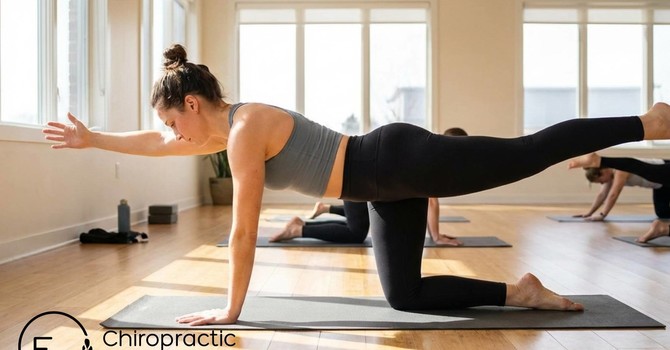
You hit the gym consistently, crush your squats, and push through heavy deadlifts. But every now and then, your low back reminds you it’s not as invincible as you’d like it to be. Whether it's a dull ache after lifting or a sharp twinge mid-rep, these are signs your core stability might not be keeping up with your strength goals.
At E3 Chiropractic + Wellness, we see it all the time—strong athletes with big lifts who end up sidelined by back pain. And here’s the hard truth: it’s not always about how much you lift. It's about how well your body stabilizes while doing it.
If you want to build a strong, pain-free back that can keep up with your training, core stability isn’t optional—it’s essential.
As your trusted Saskatoon Chiropractor, we’re here to break down why core stability matters for lifters, the most effective ways to build it, and how to integrate it into your training routine to keep your back bulletproof.
Why Core Stability Matters More Than You Think
When most people hear “core,” they think six-pack abs. But core stability goes far beyond aesthetics. It’s about how well your trunk muscles support your spine and transfer force between your upper and lower body.
Your core includes:
- Transverse abdominis (deep abdominal layer)
- Internal and external obliques
- Rectus abdominis (your “six-pack”)
- Multifidus and erector spinae (small spinal stabilizers)
- Pelvic floor muscles
- Diaphragm
Together, these muscles create intra-abdominal pressure—a supportive brace around your spine during heavy lifting. Without this pressure, your spine is left vulnerable under load, increasing the risk of disc injuries, muscle strains, and chronic instability.
The Top 3 Benefits of Core Stability for Lifters
1. Spinal Protection Under Load
A stable core acts like an internal weight belt. When you properly engage your core before a lift, you’re reducing shearing forces on your spine and distributing load evenly. This means less stress on your low back and a reduced risk of injury during squats, deadlifts, and overhead presses.
2. Improved Force Transfer and Lifting Efficiency
Your core connects your upper and lower body. If it’s weak or unstable, energy leaks during lifts—making your movements less powerful and more fatiguing. A strong, engaged core improves technique, stability, and mechanical efficiency so you can lift heavier with more control.
3. Injury Prevention Beyond the Gym
Back pain doesn’t just show up in training—it often surfaces during simple tasks like tying your shoes, shoveling snow, or getting out of bed. A stable core helps your spine handle everyday stresses without breaking down, keeping you healthier both in and out of the gym.
Common Signs Your Core Stability Needs Work
If you’re unsure whether your core is doing its job, here are a few red flags:
- Your low back always feels sore after lifting, even with good form
- You lose control at the bottom of a squat or deadlift
- You struggle to maintain bracing throughout a heavy lift
- Your hips shift or twist during squats or lunges
- You experience recurring low back "tweaks" or stiffness
If any of these sound familiar, it’s time to address your core—not with endless crunches, but with purposeful, functional training.
The Best Core Stability Exercises for Lifters
Core stability training should be about control, positioning, and breath—not just movement. These foundational exercises target deep stabilizers and reinforce proper bracing patterns.
1. Dead Bug
Why it works: Teaches you how to maintain a neutral spine while moving your limbs—a skill that translates directly to loaded lifting.
How to do it:
- Lie on your back with arms and legs in the air
- Brace your core (pull ribs down, low back flush with floor)
- Slowly lower opposite arm and leg, then return to start
- Repeat 10–12 reps per side
2. Bird Dog
Why it works: Builds anti-rotation stability and reinforces spinal alignment under dynamic control.
How to do it:
- Start on hands and knees
- Extend opposite arm and leg while keeping hips and spine steady
- Hold for 3–5 seconds, then switch sides
- Perform 8–10 reps per side
3. Plank with Breathing Focus
Why it works: Teaches bracing using intra-abdominal pressure while maintaining a stable, neutral spine.
How to do it:
- Set up in a forearm plank
- Press through forearms and engage glutes
- Inhale deeply into your belly, exhale slowly and fully
- Maintain form for 30–60 seconds
4. Pallof Press
Why it works: Challenges your ability to resist rotation—a key skill for lifting symmetry and spine safety.
How to do it:
- Stand with a cable or band to one side
- Hold the handle at chest height, then press straight out
- Keep torso square and resist twisting
- Perform 10–12 reps per side
Want to know if you’re doing these exercises correctly? At E3 Chiropractic + Wellness, we provide functional movement assessments and 1-on-1 coaching to make sure your form builds strength—not compensation patterns.
How to Integrate Core Stability into Your Lifting Program
You don’t need to overhaul your training—just make core work intentional.
Here’s how:
- Include 1–2 core stability drills in your warm-up (think dead bugs or planks)
- Add a core finisher at the end of 2–3 workouts per week
- Use “core stability” as active recovery on lighter training days
- Prioritize quality of movement over reps or resistance
The goal isn’t fatigue—it’s control. Core training should make your lifts feel more stable and your back feel more resilient.
Don’t Wait for Pain to Prioritize Core Stability
One of the most common phrases we hear from patients is, “I didn’t think my core was the problem.” But once we assess them at E3 Chiropractic + Wellness, the connection becomes clear.
Whether you’re dealing with nagging low back pain or just want to optimize your lifting, our expert Saskatoon Chiropractor team can help you:
- Identify movement restrictions or weaknesses
- Restore proper spinal alignment and control
- Build a core routine that complements your training goals
- Reduce injury risk and improve performance
Ready to Bulletproof Your Back?
A strong back starts with a stable core. And core stability isn’t just another box to check—it’s the foundation of everything you do in and out of the gym.
Don’t let preventable back pain slow down your training.
Click HERE to book a free discovery call with the team at E3 Chiropractic + Wellness in Saskatoon. We’ll help you assess your movement patterns, build better bracing habits, and create a spine-supporting strategy tailored to your lifting style and goals.
Train smart. Lift heavy. Stay pain-free.





